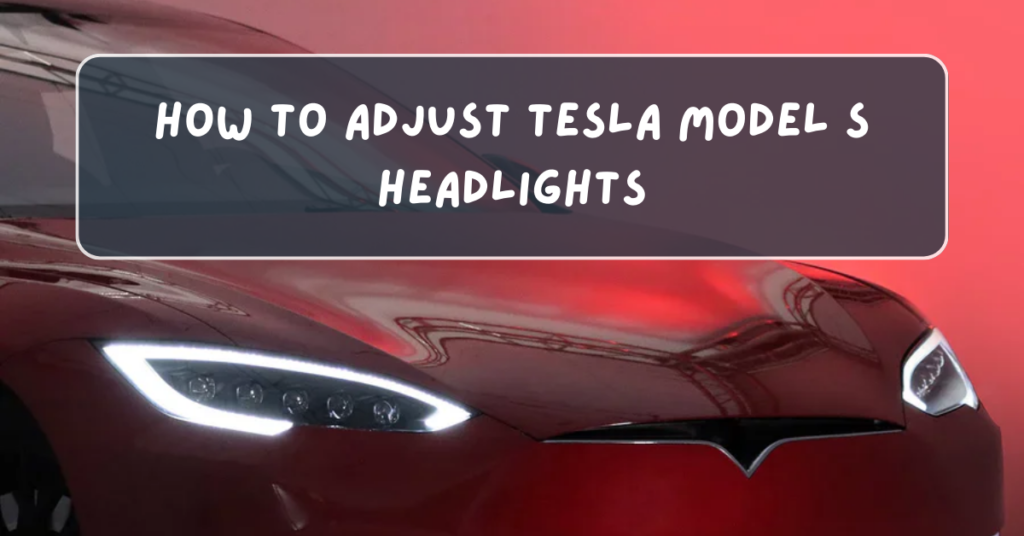
Properly adjusted headlights are essential for driving safely at night or in low-visibility conditions. If your Tesla Model S headlights are too high or too low, they can either blind other drivers or fail to adequately illuminate the road ahead. Fortunately, adjusting your Tesla Model S headlights is relatively straightforward and can be done in just a few steps. In this guide, we’ll walk you through the process of adjusting the headlights on your Tesla Model S to ensure a safer driving experience.
Why Headlight Adjustment is Important
Before diving into the steps, let’s quickly discuss why it’s important to adjust your headlights properly:
- Improved Visibility: Well-adjusted headlights ensure that the road ahead is adequately illuminated, improving your ability to see at night.
- Avoiding Glare: Incorrectly adjusted headlights can blind oncoming drivers, creating a safety hazard.
- Compliance with Regulations: Many regions have specific regulations regarding headlight height and aim, and proper adjustment ensures your Tesla complies with these rules.
Tools You’ll Need
- A Flat Surface: Ideally, you’ll want to adjust your headlights on a flat surface, like a garage floor or a parking lot.
- A Wall or Garage Door: You’ll need a wall or large door to project the headlights onto.
- Measuring Tape: This will help ensure accurate adjustment.
- A Screwdriver or Torx Wrench: The Tesla Model S typically requires a small wrench or screwdriver for the adjustment process.
Step-by-Step Guide to Adjusting Tesla Model S Headlights
1. Park Your Tesla Model S in Front of a Wall or Garage Door
- What to Do:
- Park your Tesla Model S about 10-15 feet away from a flat wall or garage door.
- Make sure the car is facing straight and that the wheels are parallel to the wall. The surface should be level to avoid misalignment during the adjustment.
2. Turn on the Headlights and Mark the Beam Pattern
- What to Do:
- Turn on your Tesla’s headlights and stand in front of the car to observe the light pattern on the wall.
- You should see a sharp cutoff line where the beam light stops. There may be horizontal and vertical lines or patterns indicating the light focus.
- Use masking tape or a marker to mark the center of the beam on the wall. This will act as a reference point during the adjustment.
3. Measure the Height of the Headlights
- What to Do:
- Measure the height of the headlight from the ground to the center of the beam on both headlights.
- Record the measurement for later use, as the goal is to adjust the beam pattern so that the horizontal cutoff aligns with this height on the wall.
4. Locate the Adjustment Screws
- What to Do:
- Open the hood of your Tesla Model S.
- On the back of each headlight assembly, you’ll find two screws or bolts used to adjust the headlights.
- Vertical Adjustment: This screw controls the up-and-down movement of the beam.
- Horizontal Adjustment: This screw controls the left-to-right movement of the beam.
- These screws are typically located near the top and side of the headlight housing.
5. Adjust the Vertical Beam
- What to Do:
- Use the vertical adjustment screw to move the headlight beam up or down.
- The goal is to position the top of the beam cutoff at the same height as the measured height of the headlights (this should be the height you recorded earlier).
- Turn the screw in small increments and check the position of the beam regularly on the wall until it is in the desired position.
6. Adjust the Horizontal Beam
- What to Do:
- Use the horizontal adjustment screw to shift the beam left or right, if necessary. The beam should be aimed directly in front of the vehicle, with the light pattern slightly favoring the right side for better visibility on the road without blinding other drivers.
- Keep the beam aligned with your marked reference points on the wall for proper direction.
7. Verify the Adjustment
- What to Do:
- After making adjustments to both the vertical and horizontal settings, step back and observe the beam patterns once again to ensure that they align with the markings you made on the wall.
- Ensure the beams are not too high (which could blind oncoming drivers) or too low (which might not illuminate the road properly).
8. Test Drive to Confirm the Adjustment
- What to Do:
- After adjusting the headlights, take your Tesla Model S for a test drive at night to verify that the headlights provide the right level of illumination.
- If the headlights are still not performing as expected, repeat the adjustment process or consider seeking assistance from a Tesla service center.
Troubleshooting Common Headlight Adjustment Issues
- Uneven Beam Pattern: If one headlight is higher than the other, check that both headlights are adjusted to the same height and make sure the car is level.
- Headlight Still Not Bright Enough: If your headlights still seem dim after adjustment, check that the bulbs are not worn out and replace them if necessary.
- No Adjustment Screws: If your Tesla Model S headlight assembly does not have manual adjustment screws, it may require professional service to make the adjustment.
Conclusion
Adjusting your Tesla Model S headlights is a simple yet effective way to improve night-time driving visibility and ensure that you’re not blinding other drivers. By following these easy-to-follow steps, you’ll be able to correctly adjust your headlights for better driving safety and comfort. If the problem persists or you’re uncomfortable performing the adjustment yourself, it’s always a good idea to consult Tesla service for professional assistance.